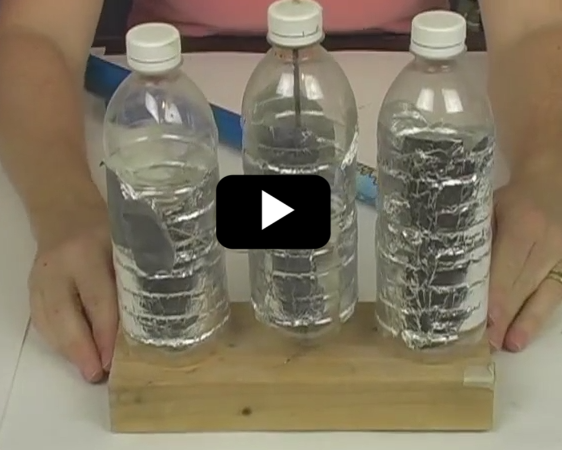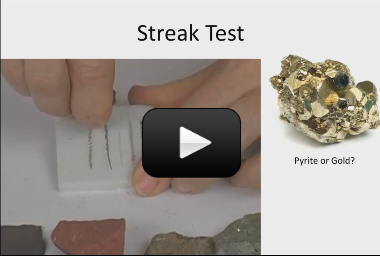This is a recording of a recent live teleclass I did with thousands of kids from all over the world. I’ve included it here so you can participate and learn, too! Learn about the world of rocks, crystals, gems, fossils, and minerals by moving beyond just looking at pretty stones and really being able to identify, test, and classify samples and specimens you come across using techniques that real field experts use. While most people might think of a rock as being fun to climb or toss into a pond, you will now be able to see the special meaning behind the naturally occurring material that is made out of minerals by understanding how the minerals are joined together, what their crystalline structure is like, and much more.
Materials:
- Geology Field Trip in a Bag
- Worksheet printout
- Unglazed porcelain tile (or the bottom of a coffee mug)
- Paper plate or disposable pie pan
- Microscope slide
- Magnifying glass
- Cup of water
- Steel nail
- Double-sided tape
- Magnet
Imagine you have a thin rope attached to a thick rope, and you jerk the thin rope so it creates a pulse that travels down the rope. When it hits the boundary between the two ropes, the wave just doesn’t stop and go away. Some of the energy from the wave is reflected back toward the source along the thin rope, and some of the energy is transmitted to the thicker (more dense) rope.
Please login or register to read the rest of this content.
If you stick a pencil is a glass of water and look through the side of the glass, you’ll notice that the pencil appears shifted. The speed of light is slower in the water (140,000 miles per second) than in the air (186,282 miles per second), called optical density, and the result is bent light beams and broken pencils.
Please login or register to read the rest of this content.
You’ll notice that the pencil doesn’t always appear broken. Depending on where your eyeballs are, you can see an intact or broken pencil. When light enters a new substance (like going from air to water) perpendicular to the surface (looking straight on), refraction does not occur.
However, if you look at the glass at an angle, then depending on your sight angle, you’ll see a different amount of shift in the pencil. Where do you need to look to see the greatest shift in the two halves of the pencil? (Hint: move the pencil back and forth slowly.)
Click here to go to next lesson on Refractive Index
We’re going to bend light to make objects disappear. You’ll need two glass containers (one that fits inside the other), and the smaller one MUST be Pyrex. It’s okay if your Pyrex glass has markings on the side. Use cooking oil such as canola oil, olive oil, or others to see which makes yours truly disappear. You can also try mineral oil or Karo syrup, although these tend to be more sensitive to temperature and aren’t as evenly matched with the Pyrex as the first choices mentioned above.
Here’s what you need:
- two glass containers, one of which MUST be Pyrex glass
- vegetable oil (cheap canola brand is what we used in the video
Published value for light speed is 299,792,458 m/s = 186,282 miles/second = 670,616,629 mph
- sink
Click here to go to next lesson on Why does light bend?
But why does light bend? You can imagine a toy car going from a wood floor to carpeting. One wheel hits the carpet first and slows down before the other, causing the toy to turn. The direction of the wave changes in addition to the speed. The slower speed must also shorten its wavelength since the frequency of the wave doesn’t change.
Please login or register to read the rest of this content.
Do you remember the eye balloon that you made earlier? The white portion of the balloon represents your sclera, which you may have already guessed is also the white part of your eye. It is actually a coating made of protein that covers the various muscle in your eye and holds everything together.
Please login or register to read the rest of this content.
Wowza… you’ve made it through the ENTIRE course in Advanced Physics! Wa-hoo!!
Time for one more video… ready?
If you’ve ever tried to skewer something under the water from above it, you know that you can’t aim directly at the object, because of the way light bends when it goes from a slower to a faster medium. Can you guess the one condition where light doesn’t bend as it crosses a boundary?
Please login or register to read the rest of this content.
How much incident light bends as it crosses a boundary can be calculated and measured if we know about the mediums, including information about the index of refraction. Snell’s Law is a mathematical relationship between the refractive and incident angles of light and the optical density of the different mediums.
Please login or register to read the rest of this content.
If you’re scratching your head during math class, wondering what you’ll ever use this stuff for, here’s a cool experiment that shows you how scientists use math to figure out the optical density of objects, called the “index of refraction”.
How much light bends as it goes through one medium to another depends on the index of refraction (refractive index) of the substances. There are lots of examples of devices that use the index of refraction, including fiber optics. Fiber optic cables are made out of a transparent material that has a higher index of refraction than the material around it (like air), so the waves stay trapped inside the cable and travel along it, bouncing internally along its length. Eyeglasses use lenses that bend and distort the light to make images appear closer than they really are.
Please login or register to read the rest of this content.
The Law of Reflection states that when light reflects off the surface, the angle of incidence is equal to the angle of reflection. Snell’s Law states that when light crosses into a new medium, the relationship between the angle of incidence (θi) and angle of refraction (θr) are related by the equation:
Please login or register to read the rest of this content.
Fiber Optics are one application of total internal reflection. Optical fibers are flexible, transparent fibers made from plastic or glass about the size of a human hair that can serve as a "light pipe" to transmit light from one location to another. The bundle of fibers is used in medical applications where doctors can see inside the body by attaching a small camera to one side of the cable. To make the project below, you can order this Fiber Optics kit.
Dispersion is when visible light is separated into the colors that make up the light. We’ve already seen how optical density is a measure of how much a medium slows down light that travels through it. The index of refraction depends on the frequency of the light.
Please login or register to read the rest of this content.
In this experiment, water is our prism. A prism un-mixes light back into its original colors of red, green, and blue. You can make prisms out of glass, plastic, water, oil, or anything else you can think of that allows light to zip through.
What’s a prism? Think of a beam of light. It zooms fast on a straight path, until it hits something (like a water drop). As the light goes through the water drop, it changes speed (refraction). The speed change depends on the angle that the light hits the water, and what the drop is made of. (If it was a drop of mineral oil, the light would slow down a bit more.) Okay, so when white light passes through a prism (or water drop), changes speed, and turns colors. So why do we see a rainbow, not just one color coming out the other side?
Please login or register to read the rest of this content.
Click here to go to next lesson on Water Drops and Rainbows
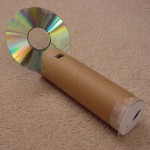 Spectrometers are used in chemistry and astronomy to measure light. In astronomy, we can find out about distant stars without ever traveling to them, because we can split the incoming light from the stars into their colors (or energies) and “read” what they are made up of (what gases they are burning) and thus determine their what they are made of. In this experiment, you’ll make a simple cardboard spectrometer that will be able to detect all kinds of interesting things!
Spectrometers are used in chemistry and astronomy to measure light. In astronomy, we can find out about distant stars without ever traveling to them, because we can split the incoming light from the stars into their colors (or energies) and “read” what they are made up of (what gases they are burning) and thus determine their what they are made of. In this experiment, you’ll make a simple cardboard spectrometer that will be able to detect all kinds of interesting things!
SPECIAL NOTE: This instrument is NOT for looking at the sun. Do NOT look directly at the sun. But you can point the tube at a sheet of paper that has the sun’s reflected light on it.
Usually you need a specialized piece of material called a diffraction grating to make this instrument work, but instead of buying a fancy one, why not use one from around your house? Diffraction gratings are found in insect (including butterfly) wings, bird feathers, and plant leaves. While I don’t recommend using living things for this experiment, I do suggest using an old CD.
CDs are like a mirror with circular tracks that are very close together. The light is spread into a spectrum when it hits the tracks, and each color bends a little more than the last. To see the rainbow spectrum, you’ve got to adjust the CD and the position of your eye so the angles line up correctly (actually, the angles are perpendicular).
You’re looking for a spectrum (the rainbow image at left) – this is what you’ll see right on the CD itself. Depending on what you look at (neon signs, chandeliers, incandescent bulbs, fluorescent bulbs, Christmas lights…), you’ll see different colors of the rainbow. For more about how diffraction gratings work, click here.
Materials:
- old CD
- razor
- index card
- cardboard tube
Like sound, light travels in waves. These waves of light enter your eyes through the pupil, which is the small black dot right in the center of your colored iris. Your lens bends and focuses the light that enters your eye. In this experiment, we will study this process of bending light and we will look at the difference between concave and convex lenses.
Please login or register to read the rest of this content.
Click here to go to next lesson on Concave Lenses
When I was in grad school, I needed to use an optical bench to see invisible things. I was trying to ‘see’ the exhaust from a new kind of F15 engine, because the aircraft acting the way it shouldn’t – when the pilot turned the controls 20o left, the plane only went 10o. My team had traced the problem to an issue with the shock waves, and it was my job to figure out what the trouble was. (Anytime shock waves appear, there’s an energy loss.)
Since shock waves are invisible to the human eye, I had to find a way to make them visible so we could get a better look at what was going on. It was like trying to see the smoke generated by a candle – you know it’s there, but you just can’t see it. I wound up using a special type of photography called Schlieren.
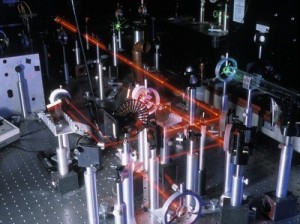 An optical table gives you a solid surface to work on and nails down your parts so they don’t move. This is an image taken with Schlieren photography. This technique picks up the changes in air density (which is a measure of pressure and volume).
An optical table gives you a solid surface to work on and nails down your parts so they don’t move. This is an image taken with Schlieren photography. This technique picks up the changes in air density (which is a measure of pressure and volume).
The air above a candle heats up and expands (increases volume), floating upwards as you see here. The Schlieren technique shines a super-bright xenon arc lamp beam of light through the candle area, bounces it off two parabolic mirrors and passes it through a razor-edge slit and a neutral density filter before reaching the camera lens. With so many parts, I needed space to bolt things down EXACTLY where I wanted them. The razor slit, for example, just couldn’t be anywhere along the beam – it had to be right at the exact point where the beam was focused down to a point.
I’m going to show you how to make a quick and easy optical lab bench to work with your lenses. Scientists use optical benches when they design microscopes, telescopes, and other optical equipment. You’ll need a bright light source like a flashlight or a sunny window, although this bench is so light and portable that you can move it to garage and use a car headlight if you really want to get creative. Once your bench is set up, you can easily switch out filters, lenses, and slits to find the best combination for your optical designs. Technically, our setup is called an optical rail, and the neat thing about it is that it comes with a handy measuring device so you can see where the focal points are for your lenses. Let’s get started:
Please login or register to read the rest of this content.
Click here to go to next lesson on Convex Lenses
Convex lenses bulge outwards, bending the light out in a spray (diverging beam). A hand-held magnifying glass is a single concave lens with a handle. These lenses have been used as ‘burning glasses’ for hundreds of years – by placing a small piece of paper at its focal point and using the sun as a light source, you can focus the light energy so intensely that you reach the flash point of the paper (the paper auto-ignites around 450oF).
Please login or register to read the rest of this content.
Imagine you were designing a pair of eyeglasses. How would you know what kind of lens to make? How curved would it be? What would the magnification be? Here’s how you use the lens maker’s equation to figure out the critical information about a lens.
Please login or register to read the rest of this content.
By using lenses and mirrors, you can bounce, shift, reflect, shatter, and split a laser beam. Since the laser beam is so narrow and focused, you’ll be able to see several reflections before it fades away from scatter. Make sure you complete the Laser Basics experiment first before working with this experiment.
You’ll need to make your beam visible for this experiment to really work. There are several different ways you can do this:
Please login or register to read the rest of this content.
Click here to go to next lesson on Line of Sight
The eye is a complex structure that detects and focuses light. Light first enters the eye through the cornea, a clear protective layer on the outside of the eye. The pupil, a black opening in the eye, lets light in. In dark rooms, the pupil will become larger, or dilate, in order to let in more light. If the room suddenly becomes bright, the pupil will become smaller. The pupil is surrounded by the brown, blue, grey, or green iris.
After passing through the pupil, light goes to the lens which, like a hand lens, is a clear curved structure that helps focus light on the retina, in the back of the eye. The retina is where the rods and cones are found.
This video is an old instructional film shown to pre-med students in the early 50s you might enjoy watching:
Click here to go to next lesson on Eye Balloon
[/amprotect]
In this lab, we are going to make an eyeball model using a balloon. This experiment should give you a better idea of how your eyes work. The way your brain actually sees things is still a mystery, but using the balloon we can get a good working model of how light gets to your brain.
Please login or register to read the rest of this content.
Click here to go to next lesson on Nearsightedness and Farsightedness
The lens in the eye changes shape to bring objects into focus. Myopia (nearsightedness) is the lens’ inability to bring objects that are far away into focus. The light gets brought into focus in front of the retina, so the eyeglasses needed to correct for this have diverging lenses.
Please login or register to read the rest of this content.
The angle that the reflected light makes with a line perpendicular to to the mirror is always equal to the angle of the incident ray for a plane (2-dimensional) surface.
We’re going to play with how light reflects off surfaces. At what angle does the light get reflected? This experiment will show you how to measure it.
Please login or register to read the rest of this content.
Click here to go to next lesson on Specular and Diffuse Reflection
The law of reflection holds true no matter what angle the light hits the surface with. Specular reflection occurs when light reflects off smooth surfaces like mirrors or quiet lakes, and diffuse reflection happens when light reflects off rough surfaces (like everything else). How the light reflects off and scatters depends on the roughness of the material.
Please login or register to read the rest of this content.
Mirrors are used to gather light and create images, like the mirror in your bathroom or those found in telescopes. We’re going to actually make a telescope a little later, but now we need to learn how the mirror makes an image in the first place.
Please login or register to read the rest of this content.
Have you ever seen a candle in a mirror? The image of the candle looks like the reflected rays seem to be coming from the image point, but they really don’t. This type of image is a virtual images, because it appears that light is coming from this location, but it’s not really the case.
Please login or register to read the rest of this content.
Ray tracing is how scientists figure out the path that light takes by looking at the speed of the wave, the optical density of the medium, and how reflective the surface is. Ray tracing shows how light can reflect, bend, change direction as it moves from one medium to another. Let’s find out how you can locate any image of any point by tracing rays.
Please login or register to read the rest of this content.
Right angle mirrors are two mirrors that are connected together to form an L-shape. What’s interesting about this is that while normally you’d have one image appear in one mirror, you can have three images appear when you put them together at right angles! Here’s how…
Please login or register to read the rest of this content.
Your optic nerve can be thought of as a data cord that is plugged in to each eye and connects them to your brain. The area where the nerve connects to the back of your eye creates a blind spot. There are no receptors in this area at all and if something is in that area, you won’t be able to see it. This experiment locates your blind spot.
Please login or register to read the rest of this content.
Click here to go to next lesson on The Lens of the Eye
Charles Benhamho (1895) created a toy top painted with the pattern (images on next page). When you spin the disk, arcs of color (called “pattern induced flicker colors”) show up around the disk. And different people see different colors!
We can’t really say why this happens, but there are a few interesting theories. Your eyeball has two different ways of seeing light: cones and rods. Cones are used for color vision and for seeing bright light, and there are three types of cones (red, green, and blue). Rods are important for seeing in low light.
One possibility is… Please login or register to read the rest of this content.
You already are familiar with what happens to an image on a plane mirror. What if the mirror is curved? Spherical mirrors are mirrors that are like a small section of a ball. (You could also argue that a plane mirror is a spherical mirror with an infinitely large radius, but let’s save that for another time…)
Please login or register to read the rest of this content.
If you’ve never done this experiment, you have to give it a try! This activity will show you the REAL reason that you should never look at the sun through anything that has lenses in it.
Because this activity involves fire, make sure you do this on a flame-proof surface and not your dining room table! Good choices are your driveway, cement parking lot, the concrete sidewalk, or a large piece of ceramic tile. Don’t do this experiment in your hand, or you’re in for a hot, nasty surprise.
As with all experiments involving fire, flames, and so forth, do this with adult help (you’ll probably find they want to do this with you!) and keep your fire extinguisher handy.
Materials:
- sunlight
- dead leaf
- magnifying glass
- fire extinguisher
- adult help
Here’s what you need to do:
Please login or register to read the rest of this content.
Click here to go to next lesson on How Concave Mirrors Create Images
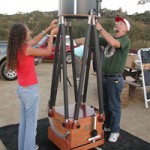 So you’ve played with lenses, mirrors, and built an optical bench. Want to make a real telescope? In this experiment, you’ll build a Newtonian and a refractor telescope using your optical bench.
So you’ve played with lenses, mirrors, and built an optical bench. Want to make a real telescope? In this experiment, you’ll build a Newtonian and a refractor telescope using your optical bench.
Materials:
- optical bench
- index card or white wall
- two double-convex lenses
- concave mirror
- popsicle stick
- mirror
- paper clip
- flash light
- black garbage bag
- scissors or razor
- rubber band
- wax paper
- hot glue
Click here to go to next lesson on Reflection Rules for Curved Mirrors
In concave mirrors, the incident parallel light traveling parallel to the principal axis passes through the focal point when it reflects. Conversely, incident parallel light traveling through the focal point will then travel parallel when it reflects.
Please login or register to read the rest of this content.
Reflection on a concave mirror uses two important basic rules: first, incident light traveling parallel to the principal axis passes through the focal point after it reflects on the surface. Second, incident light traveling through the focal point will travel parallel to the principle axis after it reflects.
Please login or register to read the rest of this content.
Spherical mirrors have aberration, which is a loss in the definition of the image because of the geometry of the mirror itself. It’s a defect in the mirror shape itself, which is caused by not being able to focus all the light to a specific point.
Please login or register to read the rest of this content.
Energy can take one of two forms: matter and light (called electromagnetic radiation). Light is energy that can travel through space. When you feel the warmth of the sun on your arm, that’s energy from the sun that traveled through space as infrared radiation (heat). When you see a tree or a bird, that’s light from the sun that traveled as visible light (red, orange… the whole rainbow) reflecting and bouncing off objects to get to your eye. Light can travel through objects sometimes… like the glass in a window.
Please login or register to read the rest of this content.
You can see objects because light from that object travels to your eyes. Sometimes light is reflected off objects before it reaches our eyes, and sometimes it comes straight from the source itself.
A candle is a light source. So is a campfire, a light bulb, and the sun. An apple, however, reflects light. It doesn’t give off any light on its own but you can see it because light waves bounce off the apple into your eye. If you shut off the light, then you can’t see the apple. In this same way, the sun is a light source, and the moon is a light reflector.
Please login or register to read the rest of this content.
This simple activity has surprising results! We’re going to bend light using plain water. Light bends when it travels from one medium to another, like going from air to a window, or from a window to water. Each time it travels to a new medium, it bends, or refracts. When light refracts, it changes speed and wavelength, which means it also changes direction.
Please login or register to read the rest of this content.
Diffraction happens when light goes around obstacles in its path. Sound waves diffract bend around obstacles, so if you’re stuck behind a pillar at a concert, you can still hear just fine.
Please login or register to read the rest of this content.
Ever play with a prism? When sunlight strikes the prism, it gets split into a rainbow of colors. Prisms un-mix the light into its different wavelengths (which you see as different colors). Diffraction gratings are tiny prisms stacked together.
When light passes through a diffraction grating, it splits (diffracts) the light into several beams traveling at different directions. If you’ve ever seen the ‘iridescence’ of a soap bubble, an insect shell, or on a pearl, you’ve seen nature’s diffraction gratings.
Scientist use these things to split incoming light so they can figure out what fuels a distant star is burning. When hydrogen burns, it gives off light, but not in all the colors of the rainbow, only very specific colors in red and blue. It’s like hydrogen’s own personal fingerprint, or light signature.
Astronomers can split incoming light from a star using a spectrometer (you can build your own here) to figure out what the star is burning by matching up the different light signatures.
Materials:
- feather
- old CD or DVD
Here’s what you do: Take a feather and put it over an eye. Stare at a light bulb or a lit candle. You should see two or three flames and a rainbow X. Shine a flashlight on a CD and watch for rainbows. (Hint – the tiny “hairs” on the feather are acting like tiny prisms… take your homemade microscope to look at more of the feather in greater detail and see the tiny prisms for yourself!
What happens when you aim a laser through a diffraction grating? Here’s what you do:
Materials:
- laser pointer
- diffraction grating (you can use an old CD also)
Download Student Worksheet & Excercises
Exercises
- Which light source gave the most interesting results?
- What happens when you aim a laser beam through the diffraction grating?
- How is a CD different and the same as a diffraction grating?
- Why does the feather work?
Click here to go to next lesson on Useful Diffraction
Do you have thick or thin hair? Let’s find out using a laser to measure the width of your hair and a little knowledge about diffraction properties of light. (Since were using lasers, make sure you’re not pointing a laser at anyone, any animal, or at a reflective surface.)
Please login or register to read the rest of this content.
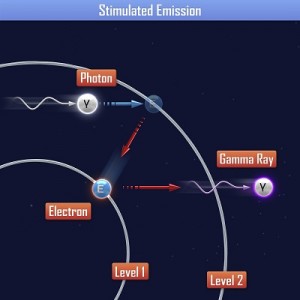 Have you ever wondered why you just can’t just shine a flashlight through a lens and call it a laser? It’s because of the way a laser generates light in the first place.
Have you ever wondered why you just can’t just shine a flashlight through a lens and call it a laser? It’s because of the way a laser generates light in the first place.
The word LASER is an acronym for Light Amplification by Stimulated Emission of Radiation.
That’s a mouthful. Let’s break it down.
Let’s do an experiment that shows you how a laser is different from light from a flashlight by looking at the wavelengths that make up the light.
Please login or register to read the rest of this content.
Click here to go to next lesson on Light Interference
Lasers light is different from light from a flashlight in a couple of different ways. Laser light is monochromatic, meaning that it’s only one color.
Laser light is also coherent, which means that the light is all in synch with each other, like soldiers marching in step together. Since laser light is coherent, which means that all the light waves peaks and valleys line up. The dark areas are destructive interference, where the waves cancel each other out. The areas of brightness are constructive interference, where the light adds, or amplifies together. LED light is not coherent because the light waves are not in phase.
Please login or register to read the rest of this content.
Polarization has to do with the direction of the light. Think of a white picket fence – the kind that has space between each board. The light can pass through the gaps int the fence but are blocked by the boards. That’s exactly what a polarizer does.
When you have two polarizers, you can rotate one of the ‘fences’ a quarter turn so that virtually no light can get through – only little bits here and there where the gaps line up. Most of the way is blocked, though, which is what happens when you rotate the two pairs of sunglasses. Your sunglasses are polarizing filters, meaning that they only let light of a certain direction in. The view through the sunglasses is a bit dimmer, as less photons reach your eyeball.
Polarizing sunglasses also reduce darken the sky, which gives you more contrast between light and dark, sharpening the images. Photographers use polarizing filters to cut out glaring reflections.
Materials:
- two pairs of polarized sunglasses
- tape (the 3/4″ glossy clear kind works best – watch second video below)
- window
Click here to go to next lesson on Shadows
The electromagnetic spectrum shows the different energies of light and how the energy relates to different frequencies. The wavelength (λ) equals the speed of light (c) divided by the frequency (ν), or λ = c / ν. The speed of light is: c = 3 x 108 m/s (300,000,000 meters per second).
Please login or register to read the rest of this content.
Do you see where the “visible light” rainbow section is in the electromagnetic spectrum image below? This small area shows the light that you can actually see with your eyeballs. Note that the “rainbow of colors” that make up our entire visible world only make up a small part of all the light, from 400-700 nm (nanometers, or 10-9.
Please login or register to read the rest of this content.
You can demonstrate the primary colors of light using glow sticks! When red, green, and blue cold light are mixed, you get white light. Simply activate the light stick (bend it until you hear a *crack* – that’s the little glass capsule inside breaking) and while wearing gloves, carefully slice off one end of the tube with strong cutters, being careful not to splash (do this over a sink).
Please login or register to read the rest of this content.
Is white or black a color? No and no. White is the mixture of all the colors (red, orange, yellow, green, blue indigo, and violet), so technically white isn’t a color of light but rather the combination of colors. Black is also not technically a color. In outer space, it’s pitch-black dark because there’s no light. In a room with the lights off, it’s also black. Black is the absence of color.
Please login or register to read the rest of this content.

